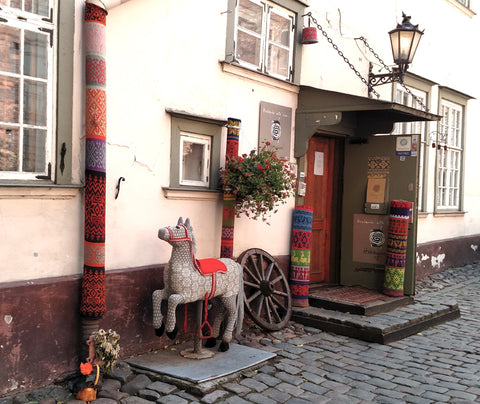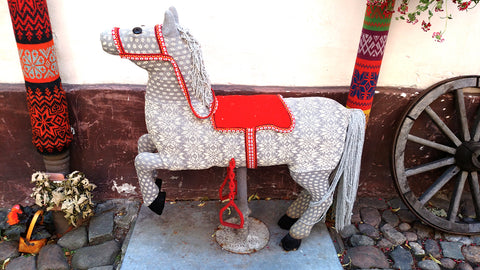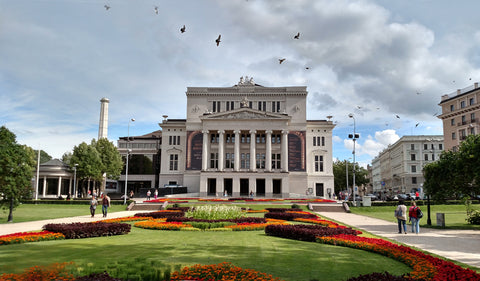Our Baltic Trip 2016, Part 6 - Riga Posted on 17 Sep 21:53 , 0 comments
The next day was our only full day in Riga. The city was beautiful, but we longed to see more of the countryside. We intended to stroll around the old town, but as we often do, we assigned ourselves a mission, to give direction to our wanderings. One of my favorite ways to explore is to visit all the yarn stores we can manage. This gave us a zigzag route that provided a good sampling of the sights of the old town. We consulted the internet to build a list of places to visit, and in particular found this blog helpful: http://www.kikamoracrafts.com/blog/read_130013/yarn-shops-in-riga-list-of-my-favorites.html. It is written by a local knitter named Laura, who Mike later met when he visited the shop she worked in on our last day in Latvia. (He bought a nice skein of local yarn for me there!)
The old town of Riga is a mix of buildings of many ages, from the founding of the German city in the 13th century into the present day. There are a number of massive churches, expansive squares, old merchant houses, grand Art Nouveau mansions and hotels, and on and on. Most are now in good repair, and the city offers, at least on a summer’s day, a bright, welcoming aspect. It is popular with tourists, but unlike Tallinn, didn’t feel overwhelmed by them.
Two of the yarn shops we visited stood out. The first is the famous Hobbywool, already well known to fans of Latvian knitting. We fingered lots of Latvian made wool, and eyed their “Knit Like A Latvian” kits. The shop is in a little alley which is VERY “yarn bombed!” I especially liked their mascot, a carousel horse fully covered in a knitted skin.

Entrance to Hobbywool

The yarn-bombed horse at the Hobbywool door
The shop that really made my heart go a-flutter was called Dzijas, which just means “yarn” in Latvian. It lies a little out of the old town, down a crooked little staircase in a basement; very obscure and a little hard to find. Once there, though, we found a small room crammed floor to ceiling with yarn of all kinds of colors, much of it unlabeled, with an opaque organization. The proprietress, however, knew every skein she had, and where to find it. It is one of those shops with just a single, narrow path through all the merchandise, and barely room for more than a couple of customers at a time. I was in heaven…and though tempted, only bought a small amount of lovely mohair silk for a future lace shawl. The absolutely gorgeous fine pearl cotton from Russia with an amazing array of colors and very reasonable price was hard to leave behind. It would have been perfect for weaving, but, alas, cotton is very heavy and we didn’t have much leeway in terms of airport rules.
After escaping from Dzijas without too much damage to the pocketbook, we crossed back over the old moat, and through the park that traces the old line of fortifications. We lingered in front of the beautiful Opera House, with its formal garden setting. Alas, nothing was playing there during our visit. We then climbed Bastion Hill for the view, and wandered back to our hotel for an afternoon break.

Riga Opera House

View of the Independence Monument from Bastion Hill
For dinner that night we went just a few doors up from our hotel to the 1221 Restaurant, considered one of the best in Riga. The name comes from the date of the building housing the restaurant, one of the oldest surviving in the old town. It was apparently built for the founder of the brotherhood of beaver hunters. We had a fine meal of modern interpretations of traditional Latvian cuisine, and watched with pity as the servers negotiated four flights of stairs to carry plates up to the rooftop terrace (we were on the second level). One has to be fit to work in this restaurant! Among the menu items that we sampled there were duck confit with black current-chocolate sauce with fresh currents and asparagus and a wonderful and quite unique pumpkin seed ice cream with chestnut orange sauce and balsamic cherries. This is the only place we’ve ever seen smoked beaver meat on the menu, although we didn’t choose to sample it.
After dinner, we took a stroll through another corner of old town, and came upon a building in the process of demolition. The façade was braced and left standing (which I would guess is required for historical preservation) while the interior was gutted. This was on a small street where, unlike most of the rest of the old town, the buildings were not so well maintained. We guessed they were all due to be modernized soon.
As we made our way back to our hotel, we could see that the neighborhood bars and restaurants were filling up with young people, most of them watching the EuroCup soccer match. The nightlife was coming alive, just like it might in Seattle’s oldest neighborhood, Pioneer Square, and countless other historic quarters in modern cities.
